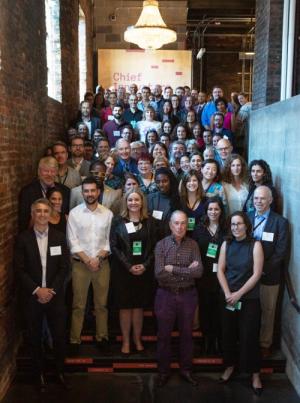7 ways to build a culture of innovation in City Hall

Chief innovation officers from 80 cities around the world gathered Sunday in Washington, D.C., for the Chief Innovators Studio — the largest ever convening of people working in that role in local government.
It was a day to celebrate how far the municipal innovation movement has come in the short time cities have been hiring for this leadership position. While their duties vary from city to city, chief innovation officers aim to leverage human-centered design, insights from behavioral science, data analytics, and citizen engagement to improve government services and create better outcomes and results for residents. A new report and interactive map from Bloomberg Philanthropies and the OECD shows a surge of commitment from cities around the world to build this internal innovation capacity.
But it also was a time for advancing ideas about how to cement these gains into place. The theme of the day’s discussions and workshops was culture change — and in particular, how to spread new approaches for solving problems across city government and build a culture that values and rewards innovation. That’s critical if this work is to survive mayoral transitions or departures of key staff.
“To be successful in the long run, you cannot do this work as an individual or as a team of innovators by yourselves as the only ones working this way in the city,” said Stephanie Wade, lead for innovation programs at Bloomberg Philanthropies. “To be truly successful, you need to scale this work across City Hall so that your way of looking at the world through innovation-colored glasses becomes the norm.”
Here are seven takeaways from the discussion.
1. Building the culture is part of a chief innovation officer’s job
City leaders face similar challenges in the early days of setting up innovation offices: explaining to city employees what they mean by innovation, getting them comfortable with new ways of working, getting some quick wins. Eventually, they have to think bigger, said Tina Walha, Director of Innovation and Performance in Seattle.
“Introducing new tools and approaches is really important,” she said, “but I think constantly about how to build a deeper passion in my colleagues to really change how government works.”
Support from political leaders, particularly the mayor, is critical. Jason Reisdorfer, Director of Innovation in Sioux Falls, S.D., said he couldn’t get far in his role if Mayor Paul TenHaken wasn’t constantly talking up the value of trying new ways of solving problems.
“Culture is modeled from the top-down,” Reisdorfer said. “It starts with the mayor. The mayor sets the bar super high and encourages risk-taking and trial and error. It’s on us as innovation chiefs to carry that down through the organization. It’s probably our number one job.”
2. Innovation needs dedicated staffing and resources
Shatha Al Hashmi, Director of Innovation in the United Arab Emirates, described the push for innovation in her country as a systemic effort with key infrastructure set up to support it.
Part of that is the Mohammed Bin Rashid Centre for Government Innovation, which she leads and has grown from two to 10 people in its five years of existence. It’s also money and staffing positions across all levels of government. All government entities are required to dedicate 1 percent of their funds to research and innovation projects, and have chief innovation officers on staff.
“They are our change agents,” Al Hashmi said. “They’re the ones who roll out the innovation agenda on the ground.”
Tessy Britton of the Participatory City Foundation likened innovation capacity to critical infrastructure. The project she leads, aimed at sparking thousands of resident-driven community projects in the East London borough of Barking and Dagenham, supports storefront spaces in the community where residents can walk in and talk with project designers who can help get their ideas off the ground.
“This is practical public social infrastructure for us in the same way as libraries, parks and roads are,” Britton said, “and it’s equally essential.”
3. Building support and buy-in from employees is critical
One obstacle innovation leaders face in local government is suspicion among City Hall colleagues that “innovation” is just a passing fad that will eventually go away. One way Sioux Falls addressed this was by asking all 1,300 employees what core values they want to see in the organization. Turns out, innovation was one of them.
“It’s been super successful,” Reisdorfer said, in part because the direction comes from employees themselves. Each month, employees now submit hundreds of “shout outs” — stories celebrating their co-workers for doing things that represent one of the core values. A traveling trophy goes to one of them each month — and for five of the first six months, “fostering innovation” is the reason the prize was awarded.
Beyond himself, Reisdorfer’s innovation shop includes only one other full-time employee and another part-timer. Rather than wait for projects to come to them, the trio spends their time out in departments, talking to them about what they need. That helps build trust and broadens his small team’s sphere of influence. It also ensures that projects that bubble up represent the departments’ own priorities.
“Go out into the Fire Department, figure out what they need and how we can help,” Reisdorfer said. “They have 100 people. A couple of them can probably dedicate resources, time, some firepower to innovation. Foster that relationship. Go out to the Health Department, see what they need. Go out to the Police Department, see what they need.”
4. Strong relationships build trust across the organization
Cultivating relationships with leaders across City Hall is critical to building interest and support for innovation initiatives. Seattle’s Walha stressed the importance of approaching people with genuine curiosity and a desire to deeply understand where they are coming from. That helps to soften some of the emotional triggers that can cause some employees to oppose innovation efforts.
“I’m a big believer in humility and history,” Walha said. “I stress that I’m here to learn from you. I want to partner with you. Tell me about something you were excited about building in the past — what you’ve tried, what’s worked and what hasn’t. It’s important to appreciate what came before.”
One new word that emerged from one of the workshops Sunday was “humbition” — meaning that innovation offices need to approach their work in a humble way that’s nevertheless driven by an ambitious desire for change. Above all, it requires staying open to people, even to opponents. “People can be annoying, but they also can be your greatest friends and collaborators,” Britton said. “Don’t get jaded. Keep welcoming new people into your work, however late to the party they are.”
5. Find and work with your champions
Everyone working in the innovation field encounters resistance, whether from individuals or organizations. Kerry O’Connor, Chief Innovation Officer in Austin, Texas, said sometimes the solution is to “be like water” and pivot to a path of less resistance that can still achieve impact. “Sometimes,” she said, “you just want to leave things well enough alone until the space ripens up a little bit, and try to get at it from another direction”
Theo Blackwell, the Chief Digital Officer in London, spoke of building “coalitions of the willing.” That’s a concept baked into the new London Office of Technology and Innovation, which aims to scale up digital innovation by coordinating the efforts of dozens of local boroughs responsible for delivering day-to-day services in the city. Rather than trying to get all 32 boroughs and five major agencies on board, Blackwell said, the effort is starting with “some of the agencies and 15 of the boroughs — those who shared our hunger for change.”
6. Help employees build their skills
The use of innovation tools can’t spread far if only a few people in City Hall know how to use them. That’s why training is such a big part of culture change. Walha cited a nine-month training program for emerging leaders in Seattle city government that teaches them innovation techniques. Baltimore, Denver, and Syracuse, N.Y., among other cities, have similar offerings.
“We coach them and encourage them to be disruptive, break through the status quo, and take risks,” Walha said. “What we’ve found is that graduates of that program have gone back to their departments, whether it’s utilities or education or early learning, and bring this work to life in an exciting way.”
Skills are spreading in Sioux Falls, as well. A recent innovation project in the city brought together 13 people from the library, police, health, and other departments to work on a problem they knew almost nothing about: improving transit service. Over nine months, they received intensive coaching in human-centered design techniques and will soon launch a pilot of an on-demand bus service. Now, members of that team, like Streets Operations Manager Dustin Hansen, are bringing those techniques to bear with teams in their own departments.
[Read: How Sioux Falls is turning public problem-solving on its head]
“They’re modeling it,” Reisdorfer said. “When they’re working on big hairy problems now, they’re pulling in an IT person, a communications person, a Health Department person, and others and saying: ‘Let’s try this together.’”
7. Put job descriptions to paper
Because only one-third of the chief innovation officers gathered have job descriptions that spell out what success means for their roles, the group on Sunday discussed, from their experience, necessary skills they should have and outcomes they should achieve.
It may sound like a basic thing, but a job description often reflects the culture of an organization. Wade said putting one on paper can help clarify what innovation is meant to achieve in City Hall. “If you don’t have one, it’s a good place to start,” she said. “When you think about culture change and innovation living beyond your tenure, it’s a big part of how you set up your successor for success, so they don’t have to fight the same battles you did.”









